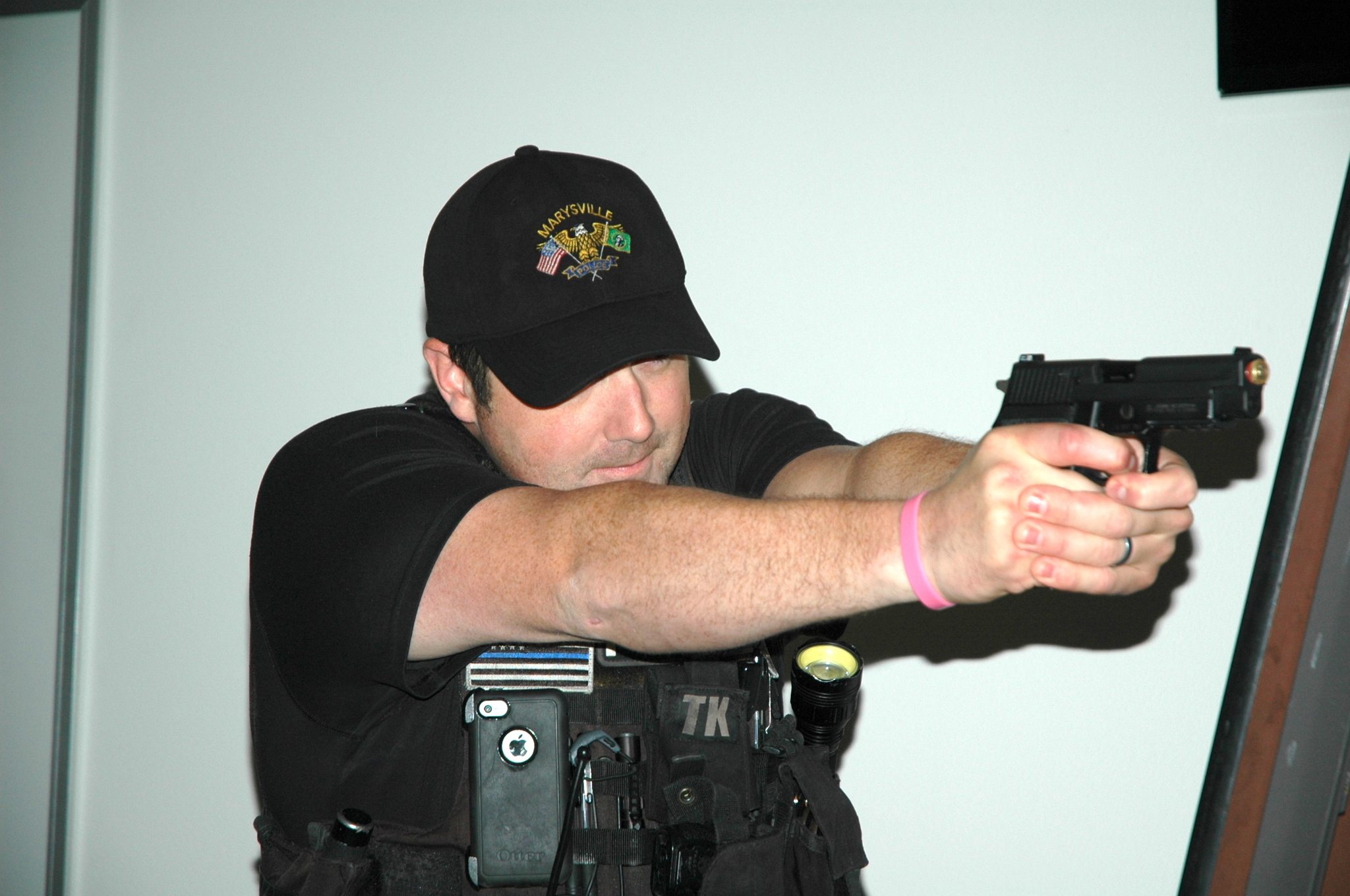MARYSVILLE — When Marysville police were loaned an interactive digital firearms training program they not only gave officers a refresher course, they also gave others insight into how police make the decision to fire their guns.
“People read news stories about how an officer shot a suspect eight times, and that might seem excessive,” Lt. Mark Thomas said. “What we hope to do is show what might have been going on, behind the scenes of that headline.”
The hour-long training starts by gauging the shooter’s basic proficiency at hitting a target, then adds more requirements to increase stress levels.
“We don’t want our officers starting from zero when they’re out in the field,” Thomas said. “A civilian who’s never been through this before might be like, ‘Oh, crap,’ but we want our officers to be inocculated to that degree of stress.”
While it’s relatively easy to hit a stationary target, the training puts shooters through their paces – from simple steps such as identifying a shape and color of object to take aim at, to complex tasks, such as spotting a firearm in a crisis and knowing when to fire.
“Our goal is never to kill, but it is to stop the threat, whatever it takes,” Thomas said. “We train our people to start with two body shots, to hit the suspect’s center of mass, but if they keep going, because they’re wearing body armor or aren’t feeling it for whatever reason, we put one in the head.”
This calculus becomes even more drastic in hostage situations, which the training simulates, first by having the shooter hit a suspect target that’s standing behind a stationary hostage, then by having that same trainee respond to an interactive video scenario of a gunman in a workplace.
“If someone is holding a bomb, can they still set it off if I hit their body?” Thomas said. “That’s why you go for the head shot. You want to stop the signal going from his brain to his hand.”
At the same time, the video exercise requires the trainee to talk to the gunman and the hostage, to try and defuse the situation.
Officer Stacey Dreyer, who’s administered the training, explained that it’s designed to test people’s “OODA loop” four-step decision cycle of “Observe, Orient, Decide and Act.”
“Anything new that enters the picture, we have to ask ourselves, what is it?” Dreyer said. “Is it a threat? What are we going to do about it? And then, we act on it. What this means, though, is that anytime a new element is introduced, it resets our OODA loop back to zero.”
Dreyer said that this is why SWAT teams often break windows and toss in flash-bangs before entering a space where a suspect is holed up, because the officers are uncertain what they’ll be facing, while the suspect has a good idea of what’s coming for him.
“If there’s only one way in, he can just plan to shoot whoever comes in,” Dreyer said. “But by banging on the side of the house, or making loud noises outside, we can reset his OODA loop to zero, so we’re on more equal footing.” Thomas added: “There’s a method to our madness. We’re not just breaking stuff to be jerks.”
Officers are often forced to fall back on this methodology with only seconds to react. Dreyer noted that officers are trained to seek cover to their left, since most shooters are right-handed and will err in the opposite direction.
Another factor is that, as Dreyer conceded, “action always beats reaction,” so officers always need to ask themselves when to start shooting and when to stop.
“Your reaction is always going to be about a second behind,” Dreyer said. “Even when you’ve made the determination that there’s no longer a threat, it takes about a second for your brain to stop sending that signal to your hand, so you can still wind up firing another shot.”
Thomas pointed out that officers are responsible for each round that leaves their guns. “It’s not like the military, where you can lay down suppressing fire,” he said. “What if one of your shots hits a random passerby? That’s still your responsibility. You’re looking at civil litigation, possibly even criminal prosecution.”
Dreyer added: “You’ll see stories in the news about how an officer unloaded on a suspect, but even a civilian can get off four rounds in a second and a half. Nobody’s standing there with a clock, to record how long it took you to fire off those rounds. You have to make a life-or-death decision, and your whole world comes down to a second and a half, for which you’ll be judged in the courts and public opinion.”
The rest of the training’s exercises are progressively more complex, forcing trainees to react to scenarios as diverse as a drunk and disorderly man with a gun in a lobby, to encountering a group of teens late at night.
“What might seem like paranoia to others is preparation for us,” Dreyer said. “You’re always playing the ‘What If?’ game with yourself, and imagining how you would respond to different scenarios. If I’m driving my patrol car down State Avenue, and I stop just behind another motorist, and he takes the time to look at me, I have to ask myself, why does he care that I’m there?”
Thomas added: “In the color-coded spectrum of stress conditions, white is your home environment, where your guard is totally down, and yellow is your workplace or your car while driving, where you know you need to be aware of what’s going on. Red is when your fight-or-flight reflex kicks in, and black is when you just shut down. Cops live in condition orange. We can’t afford to have tunnel-vision.”


